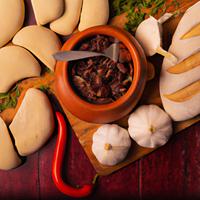
1 serving (100 grams) contains 300 calories, 6.0 grams of protein, 10.0 grams of fat, and 50.0 grams of carbohydrates.

Log this food in SnapCalorie

Nutrition Information
Calories |
714.3 | ||
|---|---|---|---|
% Daily Value* |
|||
| Total Fat | 23.8 g | 30% | |
| Saturated Fat | 4.8 g | 24% | |
| Polyunsaturated Fat | 0 g | ||
| Cholesterol | 0 mg | 0% | |
| Sodium | 476.2 mg | 20% | |
| Total Carbohydrates | 119.0 g | 43% | |
| Dietary Fiber | 4.8 g | 17% | |
| Sugars | 35.7 g | ||
| protein | 14.3 g | 28% | |
| Vitamin D | 0 mcg | 0% | |
| Calcium | 47.6 mg | 3% | |
| Iron | 2.4 mg | 13% | |
| Potassium | 119.0 mg | 2% | |
* Percent Daily Values are based on a 2,000 calorie diet. Your daily values may be higher or lower depending on your calorie needs.
Food Attributes
Source of Calories
About Nicaraguan pico bread
Pico bread is a traditional Nicaraguan pastry enjoyed for its sweet, satisfying flavor and soft texture. This dome-shaped bread is made primarily from white flour, sugar, yeast, butter, and eggs, and is often topped with a sprinkle of sugar for added sweetness. As part of Nicaraguan cuisine, Pico bread is typically served alongside coffee or as a snack. While it provides quick energy from its carbohydrate content, it is not particularly nutrient-dense due to the use of refined flour and sugar. Pico bread is low in fiber and contains moderate fat from the butter and eggs. It is best enjoyed in moderation as an occasional treat rather than a staple. For those seeking a healthier version, whole wheat flour and reduced sugar could make this beloved pastry a more nutritious option without sacrificing its classic taste.



